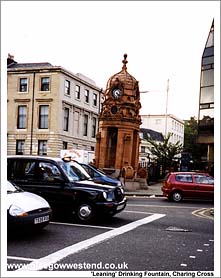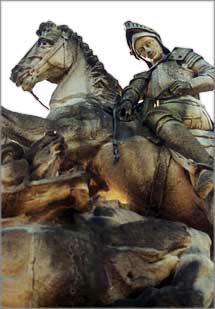Glasgow: Pat's Guide to the West End: Walks: A Scenic Route - Partick Thistle Football Club
The Scenic Route to the Firhill Thrill-Palace
Glasgow, as the world thinks it knows, has two football teams. One is found in the East End and wears the green hoops, the other is on the South Side and sports the red white and blue. Thankfully, very few people from Glasgow’s radical chic in the West End support either team, because of the sectarianism with which they are historically associated. But in fact Glasgow once had six football teams. The South Side had Third Lanark (now defunct), Clyde(now moved to Cumbernauld) and Queen’s Park - still there but with more players than fans. The former two at one time provided a surprisingly well-supported alternative to the Old Firm on the southern littoral of the Clyde. North of the river we had, and still have despite fiendish attempts to lure it to that cultural desert of East Kilbride, the Jags, or Partick Thistle. They started nearer the river as Partick Brake Club in the nineteenth century, when their ball boys sat in boats on the Clyde, and moved to Maryhill later, though still on the West End side of the Forth and Clyde Canal. Despite a relentless slide from the Premier League to the First and now the Second Division, the Jags can still attract 2-3,000 fans for their weekly penance, though at one time, like Clyde, they had regular crowds of 10,000. Their greatest attendance was in 1922 when they were only a few heads off having 50,000 watching a game against Rangers at Firhill. This came just after their one and only Scottish Cup Final win in 1921, when they beat the Gers 1-0. But just to show there is no bias at Firhill, their other great moment came with a 4-1 win over Celtic in the 1971-2 League Cup Final.
It had to be admitted that following the Thistle is hard, more of a work of charity, akin to supporting an endangered species, than enjoyment at times, but they deserve every support as an alternative, especially for young kids, to the Old Firm tribalism engaged in by 100,000 people every week. I myself though loving Glasgow like nowhere on earth, was fortunate enough to live in Aberdeen till my mid twenties, and there acquired a lifelong addiction to the Dons, not needing my weekly Jag, or fix, to immunise me form the virus of the Bhoys and the Peepul. However, there are times when I find my feet wandering northwards to Firhill on a Saturday afternoon, to watch the Thistle - and the crowd, who can often be the more entertaining, with a higher, more cerebral level of banter than the neanderthal gruntings of Old Firm fans. However, if you are going to watch the Jags, you need some compensations, and I suggest for any idle Westender or tourist, the following scenic approach to Firhill.

Start at Charing Cross, where numerous hostelries will provide the sustenance needed for your afternoon. Antonious’ Greek restaurant and the Baby Grand at Charing Cross station are places where I regularly ponder the world’s problems, and which I can recommend. Cross Sauchiehall Street from Antonious’ to Glasgow’s Leaning Tower, the fine sandstone clock monument erected in 1896 to Sir Charles Cameron, one of the City’s M.P.s, but which now has the list of a drunken Glesca keelie on a Saturday night. Walk up North Street to St George’s Cross, an area where modern flats in the new Glasgow style, are mixed with restored Victorian buildings, boldly balustraded.

One building which did not survive was a Co-operative tenement, which carried a magnificent sandstone statue of St George and the Dragon. This statue is now the centrepiece of a landscaped seating area, which however, could do with better maintenance and cleaning.
Passing up St George’s Road is a study in contrasts; alongside some of the highest multi-story blocks in Glasgow, are dotted little cameos of the past, an old town house, and St George’s in the Fields, a fine Victorian Church now also flatted. Crossing Garscube Road, you move up Baird’s Brae and come to the tow-path of the branch of the Forth and Clyde Canal which led to Port Dundas. From the later eighteenth century until the 1950s this was the port for much of Glasgow’s trade, especially the distilleries roundabouts, and at Spiers Wharf are what must be the most splendid warehouses on earth, like Adam mansions, and now also mainly converted into flats with a view of Park Circus to die for. Going to see these is worth the short detour right from the top of Baird’s Brae, but return to the Canal footbridge afterwards and continue westwards, whence tantalising glimpses of Firhill begin to appear above the dense foliage of the canal banks. You pass the ruins of Firhill Basin on the right, which was a timber depot and now seems to be converting itself it’s a Site of Scientific Interest, as well as a sight of scenic beauty, give or take a few wrecked cars and supermarket trolleys. Swans, coots and pigeons from the lofts on the bank will accompany you until you arrive at the Stadium of Dreams, or more possibly, Nighmares. If at this point you hestitate, remember, it is in a Good Cause, so get in there.
After the game you will realise it has been a long time since Charing Cross and the last caffe latte. But all roads lead to Great Western Road from Firhill, and in 10 minutes you can have left Bovril and pies behind. And one consolation is that you won’t have to watch the Jags again on TV if they got beat, since neither of the channels in the Old Firm Broadcasting Services will be showing them. That is one sure bet. Ian R. Mitchell
For information about Partick Thistle, telephone: 0141 579 1971.
Check out the following links for more information about Partick Thistle.
Over Land and Sea - http://www.chem.gla.ac.uk/~johnny/thistle/partick.html Online fanzine for Partick Thistle Football Club with lots of information including results and supporters views.
Partick Thistle - Early Years - http://www.geocities.com/pt_early_years/ Partick Thistle footbll club early history 1875-1900
Art Prints shop | Flathunting | Business Listings | Property Listings | Classified Ads | Pinboard


